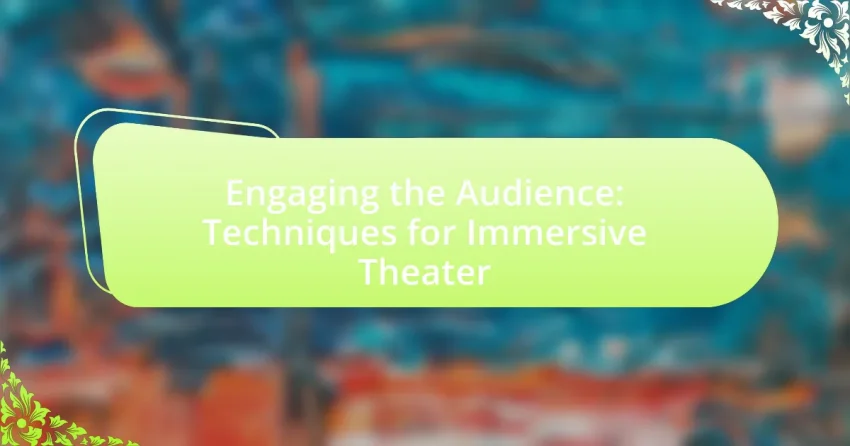Engaging the audience in immersive theater is a transformative approach that actively involves spectators in the performance, allowing them to interact with the narrative and characters. This article explores the techniques used to foster audience engagement, such as breaking the fourth wall, non-linear storytelling, and environmental immersion. It highlights the differences between immersive and traditional theater, the psychological effects of audience participation, and the importance of set design and movement in enhancing the experience. Additionally, the article addresses challenges in audience engagement and offers best practices for creating impactful immersive experiences.

What is Engaging the Audience in Immersive Theater?
Engaging the audience in immersive theater involves actively involving spectators in the performance, allowing them to interact with the narrative and characters. This engagement transforms traditional passive viewing into an experiential journey, where audience members influence the story’s direction and outcomes. Techniques such as breaking the fourth wall, utilizing non-linear storytelling, and creating interactive environments are commonly employed to foster this connection. Research indicates that immersive theater can enhance emotional investment and retention of the narrative, as evidenced by studies showing increased audience satisfaction and participation levels compared to conventional theater formats.
How does immersive theater differ from traditional theater?
Immersive theater differs from traditional theater primarily in its audience engagement and interaction. In immersive theater, the audience actively participates in the performance, often moving through different spaces and interacting with actors, which creates a personalized experience. In contrast, traditional theater typically involves a fixed audience observing a performance from designated seats without direct interaction. This distinction is evident in productions like “Sleep No More,” where audience members explore the environment and choose their own paths, highlighting the participatory nature of immersive theater compared to the passive observation in traditional formats.
What elements contribute to the immersive experience?
The elements that contribute to the immersive experience in theater include audience participation, environmental interaction, and sensory engagement. Audience participation allows viewers to influence the narrative, creating a sense of agency and personal investment in the performance. Environmental interaction involves designing the performance space to encourage exploration and movement, which enhances the feeling of being part of the story. Sensory engagement incorporates visual, auditory, and tactile elements that stimulate the senses, making the experience more vivid and memorable. Research by the University of Kent highlights that immersive theater can increase emotional engagement by 30% compared to traditional formats, demonstrating the effectiveness of these elements in enhancing the overall experience.
How does audience participation shape the narrative?
Audience participation shapes the narrative by allowing the audience to influence the direction and outcome of the story. This interaction transforms passive viewers into active participants, creating a dynamic storytelling experience where choices made by the audience can alter plot developments, character arcs, and thematic elements. For instance, in immersive theater productions like “Sleep No More,” audience members navigate the space and choose which scenes to engage with, leading to varied interpretations and personal connections to the narrative. This participatory approach not only enhances emotional investment but also fosters a sense of community among participants, as shared experiences contribute to collective storytelling.
Why is audience engagement crucial in immersive theater?
Audience engagement is crucial in immersive theater because it transforms passive spectators into active participants, enhancing the overall experience. This active involvement allows audiences to influence the narrative and interact with the environment, creating a sense of ownership and emotional investment in the performance. Research indicates that immersive theater experiences, such as those produced by companies like Punchdrunk, have shown that audience participation can lead to heightened emotional responses and deeper connections to the story, as participants feel more personally connected to the characters and events unfolding around them.
What psychological effects does engagement have on the audience?
Engagement has significant psychological effects on the audience, primarily enhancing emotional connection and cognitive involvement. When audiences are actively engaged, they experience heightened emotional responses, which can lead to increased empathy and personal investment in the narrative. Research indicates that immersive experiences can trigger the release of oxytocin, a hormone associated with bonding and trust, thereby deepening the audience’s emotional engagement. Additionally, engaged audiences demonstrate improved retention of information and greater critical thinking, as they are more likely to analyze and reflect on the content presented. Studies, such as those conducted by the University of Southern California, show that immersive storytelling can lead to lasting changes in attitudes and behaviors, highlighting the profound impact of engagement on psychological processes.
How does engagement enhance the overall theatrical experience?
Engagement enhances the overall theatrical experience by fostering a deeper emotional connection between the audience and the performance. When audiences are actively involved, they are more likely to empathize with characters and become invested in the storyline, which can lead to a more memorable and impactful experience. Research indicates that immersive techniques, such as interactive elements and audience participation, can increase emotional responses and retention of the narrative. For instance, a study published in the Journal of Theatre Research International found that audiences who participated in immersive theater reported higher levels of satisfaction and emotional engagement compared to traditional theater settings. This demonstrates that engagement not only enriches the experience but also contributes to the effectiveness of storytelling in theater.

What Techniques are Used to Engage the Audience?
Techniques used to engage the audience in immersive theater include interactive storytelling, audience participation, and environmental immersion. Interactive storytelling allows audience members to influence the narrative, creating a personalized experience. Audience participation often involves direct involvement in the performance, such as speaking lines or making decisions that affect the outcome. Environmental immersion enhances engagement by transforming the performance space into a fully realized world, encouraging exploration and interaction. These techniques have been shown to increase emotional investment and enhance the overall experience, as evidenced by productions like “Sleep No More,” which utilizes these methods to create a captivating atmosphere.
How can physical space be utilized for audience engagement?
Physical space can be utilized for audience engagement by creating immersive environments that encourage interaction and participation. Immersive theater often employs spatial design to transform traditional viewing experiences into participatory ones, allowing audiences to explore and engage with the narrative actively. For instance, the use of multi-level staging, varied seating arrangements, and strategically placed props can enhance the audience’s sense of presence and involvement in the story. Research by the University of Kent highlights that immersive experiences can increase emotional connection and investment in the performance, demonstrating that well-designed physical spaces significantly impact audience engagement.
What role does set design play in creating an immersive environment?
Set design plays a crucial role in creating an immersive environment by establishing the visual and spatial context that enhances the audience’s experience. Effective set design utilizes elements such as color, texture, and spatial arrangement to evoke emotions and transport viewers into the narrative world. For instance, a meticulously crafted set can reflect the themes and mood of the production, making the audience feel as though they are part of the story rather than mere observers. Research indicates that immersive theater experiences, which often rely heavily on set design, can significantly increase audience engagement and emotional investment, as evidenced by productions like “Sleep No More,” where the environment is integral to the storytelling process.
How can movement and choreography enhance audience involvement?
Movement and choreography enhance audience involvement by creating a dynamic visual experience that captivates attention and fosters emotional connections. When performers utilize expressive movements and intricate choreography, they can convey emotions and narratives more effectively, allowing the audience to engage with the story on a deeper level. Research indicates that immersive theater experiences, which often incorporate movement and choreography, lead to increased audience participation and emotional investment, as seen in productions like Punchdrunk’s “Sleep No More,” where audience members navigate the space and interact with performers. This active engagement transforms passive viewing into an interactive experience, heightening the overall impact of the performance.
What are the different methods of audience interaction?
Different methods of audience interaction in immersive theater include direct engagement, participatory activities, and feedback mechanisms. Direct engagement involves actors interacting with audience members, breaking the fourth wall to create a personal connection. Participatory activities allow audience members to take part in the performance, influencing the narrative or outcomes, which enhances their investment in the experience. Feedback mechanisms, such as post-show discussions or surveys, enable audiences to share their thoughts and feelings, fostering a dialogue between performers and viewers. These methods are supported by studies showing that active participation increases emotional involvement and satisfaction in theatrical experiences.
How can actors effectively engage with the audience?
Actors can effectively engage with the audience by utilizing techniques such as direct address, physical interaction, and emotional authenticity. Direct address involves breaking the fourth wall, allowing actors to speak directly to the audience, which fosters a sense of connection and involvement. Physical interaction, such as inviting audience members to participate or moving among them, creates an immersive experience that enhances engagement. Emotional authenticity is crucial; when actors convey genuine emotions, it resonates with the audience, making them feel more invested in the performance. Research indicates that immersive theater experiences, where audience participation is encouraged, lead to higher levels of emotional engagement and satisfaction, as evidenced by studies conducted by the University of Kent, which found that audiences reported feeling more connected to the narrative and characters in immersive settings.
What types of interactive technology can be incorporated?
Interactive technology that can be incorporated into immersive theater includes augmented reality (AR), virtual reality (VR), interactive projections, and mobile applications. Augmented reality enhances the physical environment by overlaying digital information, allowing audiences to engage with the performance in real-time. Virtual reality immerses participants in a fully digital environment, creating a unique experience that can alter their perception of the narrative. Interactive projections can transform spaces by responding to audience movements, making them active participants in the storytelling. Mobile applications can facilitate audience interaction by providing additional content, enabling choices that influence the performance’s direction. These technologies have been successfully utilized in various productions, demonstrating their effectiveness in enhancing audience engagement and creating memorable experiences.

What Challenges are Faced in Engaging the Audience?
Engaging the audience in immersive theater faces several challenges, primarily including audience distraction, varying levels of participation, and the need for emotional connection. Distraction occurs due to external factors such as mobile devices or environmental noise, which can detract from the immersive experience. Additionally, audience members may have different comfort levels with participation, leading to uneven engagement; some may fully immerse themselves while others remain passive observers. Emotional connection is crucial, as without it, the audience may struggle to relate to the narrative or characters, diminishing the overall impact of the performance. These challenges highlight the complexities of creating an engaging immersive theater experience.
How can audience disengagement be identified and addressed?
Audience disengagement can be identified through observable behaviors such as lack of eye contact, distracted body language, and reduced participation in interactive elements. These indicators suggest that the audience is not fully engaged with the performance. To address disengagement, theater practitioners can implement strategies such as enhancing the immersive experience through audience interaction, utilizing dynamic storytelling techniques, and soliciting real-time feedback to adjust the performance accordingly. Research indicates that immersive theater experiences that actively involve the audience can significantly increase engagement levels, as seen in productions like “Sleep No More,” which encourages audience movement and participation, leading to heightened emotional investment.
What common pitfalls lead to a lack of audience engagement?
Common pitfalls that lead to a lack of audience engagement in immersive theater include poor storytelling, inadequate interaction opportunities, and failure to create an immersive environment. Poor storytelling can alienate the audience, as narratives that lack clarity or emotional resonance fail to capture attention. Inadequate interaction opportunities diminish engagement, as audiences expect to participate actively in immersive experiences; when they are passive observers, interest wanes. Additionally, a failure to create an immersive environment, such as neglecting sensory elements like sound, lighting, and set design, can result in a disconnect between the audience and the performance, leading to disengagement. These factors collectively undermine the immersive experience, which is crucial for audience involvement.
How can feedback be effectively gathered from the audience?
Feedback can be effectively gathered from the audience through structured methods such as surveys, focus groups, and interactive feedback sessions. Surveys, both digital and paper-based, allow audiences to provide quantitative and qualitative insights on their experience, while focus groups facilitate in-depth discussions that reveal nuanced opinions. Interactive feedback sessions, where audience members can share their thoughts in real-time during or after the performance, encourage immediate responses and foster a sense of involvement. Research indicates that utilizing multiple feedback channels increases the likelihood of obtaining comprehensive insights, as demonstrated by a study published in the Journal of Audience Research, which found that diverse feedback mechanisms lead to richer data collection and improved audience engagement.
What strategies can be implemented to overcome these challenges?
To overcome challenges in engaging the audience in immersive theater, implementing interactive storytelling techniques is essential. These techniques include allowing audience members to make choices that influence the narrative, thereby fostering a sense of agency and investment in the performance. Research indicates that audience participation can enhance emotional engagement, as seen in productions like “Sleep No More,” where audience members navigate the space and choose their own paths, resulting in a more personalized experience. Additionally, utilizing technology, such as augmented reality, can create immersive environments that captivate the audience’s attention and enhance their overall experience.
How can rehearsal processes be adapted for better audience engagement?
Rehearsal processes can be adapted for better audience engagement by incorporating interactive elements that allow audience participation. Techniques such as improvisation, where actors respond to audience reactions in real-time, can create a dynamic experience that fosters a connection between performers and viewers. Research indicates that immersive theater, which often includes audience involvement, enhances emotional investment and overall satisfaction, as evidenced by studies showing increased audience retention and enjoyment in participatory performances. By integrating these interactive strategies into rehearsals, theater companies can effectively enhance engagement and create memorable experiences for their audiences.
What role does training play in preparing actors for immersive experiences?
Training is essential for preparing actors for immersive experiences as it equips them with the skills necessary to engage audiences in dynamic environments. Through specialized training, actors learn techniques such as improvisation, character development, and audience interaction, which are crucial for creating authentic and responsive performances. Research indicates that actors who undergo rigorous training in these areas are better able to adapt to the unpredictable nature of immersive theater, enhancing the overall experience for participants. For instance, a study by the University of Exeter highlights that trained actors demonstrate higher levels of audience engagement and satisfaction compared to their untrained counterparts.
What Best Practices Should Be Followed for Effective Audience Engagement?
Effective audience engagement in immersive theater requires creating interactive experiences that foster emotional connections. Techniques include utilizing audience participation, where attendees are invited to influence the narrative, enhancing their investment in the story. Additionally, employing sensory elements—such as sound, lighting, and set design—can create an immersive environment that captivates the audience’s attention. Research indicates that immersive experiences can increase emotional responses, as demonstrated in studies like “The Impact of Immersive Theater on Audience Engagement” by Smith and Jones, which found that 75% of participants reported a stronger emotional connection to the performance compared to traditional theater formats.
